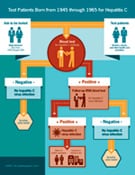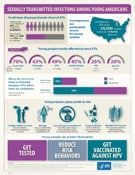2013 NCHHSTP Newsroom Archive
These media materials are no longer being updated and remain for historical context. Visit NCHHSTP Newsroom for the most current information.
- October 24, 2013 – CDC Issues Provisional Guidance for Bedaquiline, a New Drug Available to Treat MDR TBFollowing 20 years of declines, TB rates are at an all-time low in the United States (9,945 cases in 2012). However, drug resistance poses a serious threat to TB control nationally and around the world. While drug resistant cases account for a small portion of TB cases in the U.S., it is more difficult and costly to treat, more often fatal, and leaves patients with fewer treatment options.Bedaquiline, approved by the FDA in December 2012, belongs to the first new class of TB drugs to be approved to treat this deadly disease in over 40 years. CDC has released provisional guidelines for the use of this drug, which is available to treat multidrug-resistant TB (MDR TB).The new guidelines are published in the October 25, 2013 issue of the Morbidity and Mortality Weekly Report. Please find below materials to help you cover this important story.Primary Materials
- MMWR Recommendations and Reports: Provisional CDC Guidelines for the Use of and Safety Monitoring of Bedaquiline Fumarate (Sirturo) for the Treatment of Multidrug-Resistant Tuberculosis
- Media Summary: Provisional CDC Guidelines for the Use of and Safety Monitoring of Bedaquiline Fumarate (Sirturo) for the Treatment of Multidrug-Resistant Tuberculosis
Related Materials
- Fact Sheet: TB Drug Resistance in the U.Spdf icon
- Fact Sheet: TB in the US: A Snapshotpdf icon
- Fact Sheet: Tuberculosis: An Overviewpdf icon
- September 27, 2013 – National Gay Men’s HIV/AIDS Awareness DayNational Gay Men’s HIV/AIDS Awareness Day reminds us that gay and bisexual men remain at the center of the HIV epidemic in the United States. While only representing two percent of the U.S. population, men who have sex with men (MSM) account for more than 60 percent of new infections and half of all Americans living with HIV. Young MSM are the only risk group where new infections are increasing, with a 22 percent increase in recent years.For your stories about National Gay Men’s HIV/AIDS Awareness Day, please find below resources for your coverage of this important topic.Primary Materials
- Quotes for attribution to Dr. Jonathan Mermin, Director of CDC’s National Center for HIV/AIDS, Viral Hepatitis, STD, and TB Prevention
Related Materials
- Fact Sheet: HIV and AIDS among Gay and Bisexual Menpdf icon
- July 15, 2013 – New Gonorrhea Treatment Regimens Successfully Treated Infections in Clinical TrialTwo new antibiotic regimens using existing drugs – injectable gentamicin in combination with oral azithromycin and oral gemifloxacin in combination with oral azithromycin –successfully treated gonorrhea infections in a clinical trial. The trial was conducted by the Centers for Disease Control and Prevention (CDC) and the National Institutes of Health (NIH) to identify new treatment options in the face of growing antibiotic resistance.The findings will be presented this week by CDC’s Robert Kirkcaldy, M.D., at the 20th Meeting of The International Society for Sexually Transmitted Diseases Research (ISSTDR) in Vienna, Austria. Dr. Kirkcaldy served as the clinical trial’s principal investigator.Included below are resources for your coverage of this important topic.Primary Materials
- Press Release: Two New Promising Gonorrhea Treatment Regimens
Related Materials
- Fact Sheet: Antibiotic Treatment of Gonorrheapdf icon
- Fact Sheet: Gonorrhea
- Expert Bios: From CDC’s Division of STD Prevention – Dr. Gail Bolan, Director, and Dr. Robert Kirkcaldy, Medical Epidemiologist
- June 27, 2013 – National HIV Testing Dayexternal iconOf the 1.1 million people currently living with HIV in the United States, CDC estimates that nearly one in five are unaware of their infections (18 percent). This is particularly concerning because almost half of new infections are transmitted by people who do not know they are infected.Testing is the only way to identify the more than 200,000 Americans who do not know they are infected and who urgently need HIV care and prevention services. National HIV Testing Day serves not only as a reminder that HIV remains a serious health problem in this country, but also as an opportunity for individuals to take action by taking the test.Included below are various resources to assist with your coverage of this important topic.Primary Materials
- Quotes for attribution to Dr. Jonathan Mermin, Director for CDC’s Division of HIV/AIDS Prevention
- Bio and Photoimage icon of Dr. Mermin
- Fact Sheet: HIV Testing in the United Statespdf icon
Related Materials
- Fact Sheet: HIV and AIDS in America: A Snapshotpdf icon
- Events: National HIV Testing Day
- Quotes for attribution to Dr. Jonathan Mermin, Director for CDC’s Division of HIV/AIDS Prevention
- June 12, 2013 – Study Shows That A Daily Dose of HIV Medication Reduces Infection Risk among People Who Inject DrugsA daily dose of a medication used to treat HIV infection – a prevention strategy known as pre-exposure prophylaxis (PrEP) – reduced the risk of infection among people who inject drugs by 49 percent according to a new study announced today. Those who took the medication most consistently had even higher levels of protection – in this group, risk was reduced by over 70 percent.The findings were published online today in the Lancet. CDC also published interim guidance for providers who wish to prescribe PrEP to people who inject drugs in this week’s Morbidity and Mortality Weekly Report.To help inform your stories on this groundbreaking research, please find below key materials outlining the trial’s results, as well as additional background information on PrEP. If you are a reporter and need a copy of the Lancet paper, please contact the NCHHSTP media team at NCHHSTPMediaTeam@cdc.gov.Primary Materials
- Press Release: Study Finds First Evidence that PrEP Can Reduce HIV Risk Among People Who Inject Drugs
- Fact Sheet: Bangkok Tenofovir Study: PrEP for HIV Prevention Among People Who Inject Drugspdf icon
- Interim Guidance: Update to Interim Guidance for Pre-Exposure Prophylaxis (PrEP) for the Prevention of HIV Infection: PrEP for Injecting Drug Users
- Downloadable Photos for Media Use/Reprint
Related Materials
- June 12, 2013 – New CDC Campaign: Know Hepatitis BToday, CDC launched Know Hepatitis B, the first national multilingual, multi-year communications campaign to increase testing for hepatitis B among Asian Americans and Pacific Islanders.While making up only less than 5 percent of the U.S. population, Asian Americans and Pacific Islanders account for more than half of the 1.2 million Americans estimated to be living with chronic hepatitis B. Yet most of those living with the disease don’t know it because they haven’t been tested. Left undiagnosed and untreated, hepatitis B can cause serious liver damage and even death.To assist with your coverage of this new important campaign, please find below various media resources.Primary Materials
- Press Release: CDC launches first national campaign to increase hepatitis B testing among Asian Americans and Pacific Islanders
- Fact Sheet: Know Hepatitis B – Combating One of the Most Severe Health Disparities Facing Asian Americans and Pacific Islanderspdf icon
Related Materials
- Downloadable Campaign Images for Media Use/Reprint
- Campaign Website: Know Hepatitis B
- June 6, 2013 – Reasons/Razones: New CDC Campaign Aims to Increase HIV Testing Among Latino Gay and Bisexual Men
In an effort to increase HIV testing among one of the hardest hit groups of men in the United States, CDC is launching a new national, bilingual campaign that asks Latino gay and bisexual men to consider their reasons for getting tested. The campaign, Reasons/Razones, was developed with input from more than 150 Latino gay and bisexual men, as well as community leaders and experts. Reasons/Razones is launching today in Los Angeles, one of the cities with the most severe HIV epidemics in this population.
Please find below several resources to assist with your coverage of this important new campaign.
Primary Materials
- Press Release: English or Español
- Campaign Backgrounder: Englishpdf icon or Españolpdf icon
Related Materials
- Downloadable Campaign Images for Media Use/Reprint
- Campaign Website: Reasons/Razones
- Fact Sheet: Act Against AIDSpdf icon
- Fact Sheet: Act Against AIDS Leadership Initiativepdf icon

- May 7, 2013 – Hepatitis Awareness MonthToday, and in conjunction with Hepatitis Awareness Month, CDC released a new analysis in Vital Signs suggesting that only half of those identified as ever having had hepatitis C in a multi-area study received follow-up testing showing that they are still infected.These findings show that lack of follow-up testing may pose a significant barrier to reaching the millions of Americans living with hepatitis C and ensuring these individuals receive the proper care and treatment needed to prevent liver cancer, death, and other serious health consequences. The results also further underscore the severe impact that hepatitis C has among baby boomers (those born from 1945 through 1965).Please visit our media resources page for more information you can use in your coverage, including a press release, fact sheet and downloadable infographic.
- April 3, 2013 – STD Awareness MonthSTD Awareness Month is the right time to shed light on an epidemic that affects many young Americans, yet remains hidden. Did you know that:
- Half of the estimated 20 million sexually transmitted infections (STIs) that occur each year in the United States occur among young adults ages 15-24?
- The lifetime cost of treating the STIs contracted in one year in this nation is nearly $16 billion; infections among young people account for about half of that cost ($7.8 billion)?
- Left untreated, common STIs can cause severe health consequences, including infertility and increased HIV risk?
To help inform your stories on this important topic, please find below an infographic highlighting this and other key information on this hidden epidemic among America’s youth.
Primary Materials
- Infographic: Sexually Transmitted Infections among Young Americans
- Commentary – In this piece on CNN.com, Dr. Gail Bolan, Director, CDC’s Division of STD Prevention discusses how sexually active young people can stay safeexternal icon.
Related Materials
- March 24, 2013 – World TB Day: New U.S. Data for 2012In advance of World TB Day on March 24 – the annual event commemorating the date in 1882 when Dr. Robert Koch announced his discovery of the bacteria that cause tuberculosis – CDC has released preliminary national surveillance data for 2012. The new data show that after 20 consecutive years of declines, TB is at an all-time low in the United States. However, certain populations continue to be significantly affected by TB and drug resistance remains a concern.For your stories about World TB Day, please find fact sheets and key graphics highlighting findings from the 2012 U.S. TB surveillance data.Primary Materials
- Fact Sheet: TB in the United States – A Snapshotpdf icon
Related Materials
- Fact Sheet: Tuberculosis – An Overviewpdf icon
- Downloadable graphics for media use/reprint: Key Graphics from 2012 U.S. TB Surveillance Data
- Full Report: Trends in Tuberculosis – United States – 2012
- MMWR: Tuberculosis Control Activities after Hurricane Sandy – Northeast and Mid-Atlantic States, 2012
- World TB Day Resources
- March 4 – 6, 2013 – 2013 Conference on Retroviruses and Opportunistic Infections (CROI)More than 4,000 leading researchers and clinicians from around the world – including those from here at CDC – will convene in Atlanta, Georgia from March 3 through 6, 2013 for the 20th Conference on Retroviruses and Opportunistic Infections (CROI). The conference will include new research working to understand, prevent and treat HIV/AIDS and its complications.For your stories about CROI, please find resources below including CDC’s official statement on the Vaginal and Oral Interventions to Control the Epidemic (VOICE) HIV prevention trial results from Dr. Jonathan Mermin, Director for the Division of HIV/AIDS Prevention. The National Institutes of Health-led trial, which was conducted among women in South Africa, examined the use of pre-exposure prophylaxis (PrEP) strategies for reducing the risk of HIV infection among this high risk population. These results demonstrate that adherence is essential for PrEP to effectively protect against HIV infection.You can also find a “studies of interest” document highlighting key findings from noteworthy CDC research presented at this year’s conference, as well as helpful media fact sheets about HIV.Primary Materials
- Media Statement: In Wake of Latest Trial Results, CDC Stresses That Consistent Use Is Imperative When Using Pre-Exposure Prophylaxis to Prevent HIV Infection
- Studies of Interest: CROI 2013 Studies of Interest
Related Materials
- Fact Sheet: Pre-Exposure Prophylaxis (PrEP) for HIV Preventionpdf icon
- Fact Sheet: HIV in the United Statespdf icon
- February 13, 2013 – New CDC Analysis Reveals Severe Health and Economic Toll of Sexually Transmitted Infections in the US, Especially Among YouthPrimary Materials
- Fact Sheet: Incidence, Prevalence, and Cost of Sexually Transmitted Infections in the United Statespdf icon
Related Materials
- Fact Sheet: STD Trends in the United States: 2011 National Data for Chlamydia, Gonorrhea and Syphilispdf icon
- Downloadable Graphics for media use/reprint
- February 4, 2013 – National Black HIV/AIDS Awareness DayPrimary Materials
- Statement: NBHAAD – A Day to Remember and to Act, by Dr. Jonathan Mermin, Director, Division of HIV/AIDS
Related Materials
- Video Statement

- Downloadable Videos and Graphics
- Individual Stories: Voices of African Americans Living with HIV
- Backgrounder: Let’s Stop HIV Together Campaignpdf icon
- Fact Sheet: HIV among African Americanspdf icon



